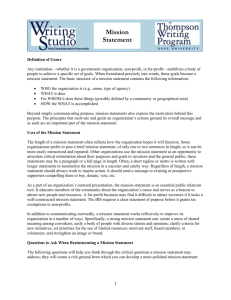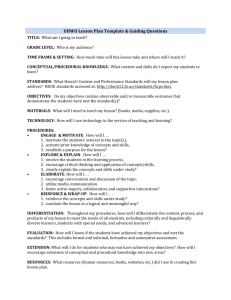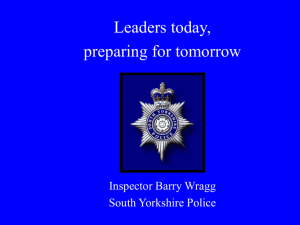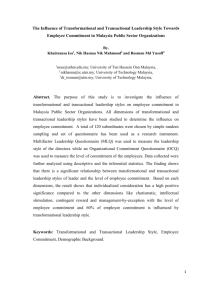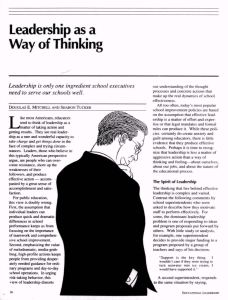Leadership v. Management: What's the Difference?
advertisement
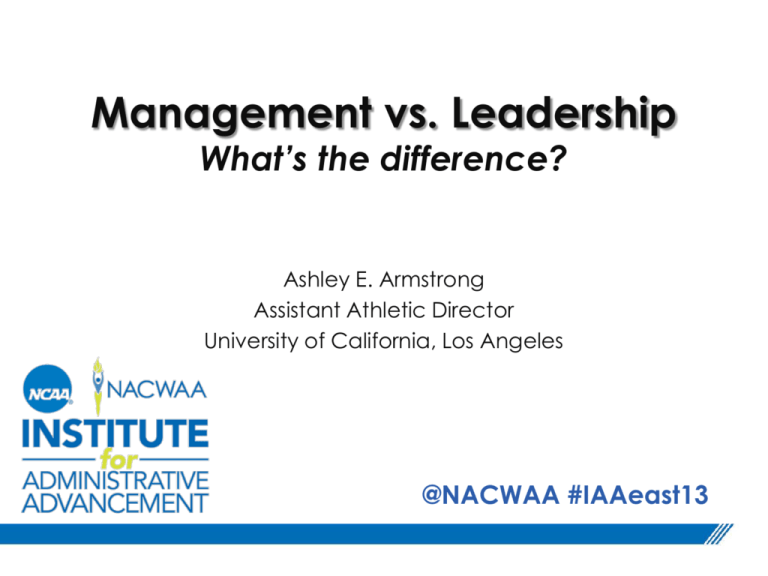
Management vs. Leadership What’s the difference? Ashley E. Armstrong Assistant Athletic Director University of California, Los Angeles @NACWAA #IAAeast13 Leadership vs. Management • • • • • College Athletics Management & Leadership Management vs. Leadership Would you manage or lead? Keys to Being Effective @NACWAA #IAAeast13 College Athletics • • • • • • Complex Competitive Higher Education vs. Big Business Media Driven Constant Change Multi-Generational @NACWAA #IAAeast13 Management & Leadership • • • • Used interchangeably. Each has its own function and characteristics. Both tied to human interaction. Exist at every level. @NACWAA #IAAeast13 “Leadership is about coping with change. Management is about coping with complexity.” John Kotter “Leaders are people who do the right thing; Managers are people who do things right.” Warren Bennis @NACWAA #IAAeast13 Task vs. People Managers focus on task. • Process, procedure, structure, and outcomes. Leaders focus on people. • Inspire, influence, motivate, and persuade. @NACWAA #IAAeast13 Stability vs. Change Managers maintain stability. • Produce order and consistency. • Control systems and people. • Avoid risks… Accept status quo. Leaders create change. • Develop a vision and share the big picture. • Innovators that initiate new ideas. • Willing to take risks… Challenge status quo. @NACWAA #IAAeast13 Goal vs. Vision Managers execute goals. • Break down the plan into incremental goals. • Produce orderly and consistent results. • Short range view. Leaders articulate a vision. • Unify people behind a cause. • Find opportunities and create strategies. • Long term perspective. @NACWAA #IAAeast13 Directs vs. Shapes Managers direct culture. • Define the plan… Who, what, when , where, why? • Ensure that rules and procedures are followed. • Navigate existing roads. Leaders shape culture. • Empower and inspire innovation. • Motivate the team. • Lead the way on new roads. @NACWAA #IAAeast13 Organize vs. Align Managers organize when things go wrong. • Embrace the process. • Seek stability and control. • Avoid conflict and try to resolve problems quickly. Leaders align when things go wrong. • Tolerate chaos and lack of structure. • Rally the troops, reestablish the vision, and set the direction. • Use conflict to motivate action. @NACWAA #IAAeast13 Transactional vs. Transformational Managers have subordinates. • Use an authoritative, transactional style. • Power over people. • Motivate through reward and punishment. Leaders have followers. • Use a charismatic, transformational style. • Power with people. • Motivate through persuasion and extrinsic rewards. @NACWAA #IAAeast13 MANAGERS LEADERS Task Focused People Focused Maintain Stability Produce Change Execute Goals Inspire Vision Direct Culture Shape Culture Organize and Staff Align People Transactional Transformational Authority & Control Persuasion & Influence @NACWAA #IAAeast13 Do You Manage or Lead? An employee comes into your office with a problem or issue. They explain the whole scenario to you. You have two choices: 1. Tell them what to do, and then ask them what questions they may have about your solution. 2. Ask them what they think are possible solutions, and which they think would work best. How would you handle this situation? @NACWAA #IAAeast13 Effective Leaders & Managers 1. 2. 3. 4. Self Awareness. Emotional Intelligence. Know Your People. Resilience. @NACWAA #IAAeast13 Find a Balance • Leadership without management can result in chaos and inefficiency. • Management without leadership can result in tunnel vision and paralysis. • Strong management skills and leadership skills are necessary to be successful. @NACWAA #IAAeast13


